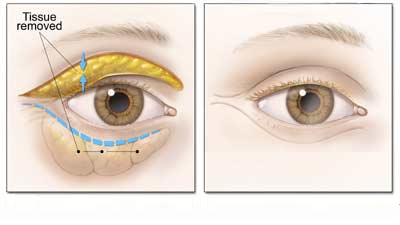Blepharoplasty in India
What is Blepharoplasty ?
Blepharoplasty (Greek: blepharon, “eyelid” + plassein “to form”) is the plastic surgery operation for correcting defects, deformities, and disfigurations of the eyelids; and for aesthetically modifying the eye region of the face. With the excision and the removal, or the repositioning (or both) of excess tissues, such as skin and adipocyte fat, and the reinforcement of the corresponding muscle and tendon tissues, the blepharoplasty procedure resolves functional and cosmetic problems of the periorbita, which is the area from the eyebrow to the upper portion of the cheek.
In an eye surgery procedure, the usual correction or modification (or both) is of the upper and the lower eyelids, and of the surrounding tissues of the eyebrows, the upper nasal-bridge area, and the upper portions of the cheeks, which are achieved by modifying the periosteal coverings of the facial bones that form the orbit (eye socket).
The periosteum comprises two-layer connective tissues that cover the bones of the human body:
(i) the external layer of networks of dense, connective tissues with blood vessels,
(ii) the internal, deep layer of collagenous bundles composed of spindle-shaped cells of connective tissue, and a network of thin, elastic fibres.
Removal of single eyelid
East Asian blepharoplasty, also known as "double eyelid surgery", is a type of cosmetic surgery where the skin around the eye is reshaped (blepharoplasty). The purpose of the procedure is to create an upper eyelid with a crease (i.e. "double eyelid") from an eyelid that is naturally without a crease (a.k.a. "single eyelid" or "monolid").
Anatomically, there are a number of subtle differences in the upper eyelids of many East Asians, compared with the eyelids of Caucasians.[8] While some East Asians have a double eyelid and some do not, there is also a large variation in the crease position (double eyelid size) of the East Asian upper eyelid. The upper lid fold can range from 1 mm (0.039 in) above the eyelash line to about 10 mm (0.39 in).
Blepharoplasty

Procedures
A blepharoplasty procedure usually is performed through external surgical incisions made along the natural skin lines (creases) of the upper and the lower eyelids, which creases then hide the surgical scars from view, especially when effected in the skin creases below the eyelashes of the lower eyelid.
The anatomic condition of the eyelids, the (wear-and-tear) quality of the patient’s skin, his or her age, and the general condition of the adjacent tissues, consequent to the anatomic conditions of the patient, affect the functional and aesthetic results achieved with the eyelid surgery. Additional to the anatomic conditions of the eye region of the patient, the occurrence, or not, of medical complications is determined by factors such as:
Dry-eye syndrome — which can become exacerbated by the disruption of the natural, lacrimal (tear) film of the eyes
Palpebral skin laxity — looseness of the lower eyelid margin, which predisposes the lower eyelid to malposition